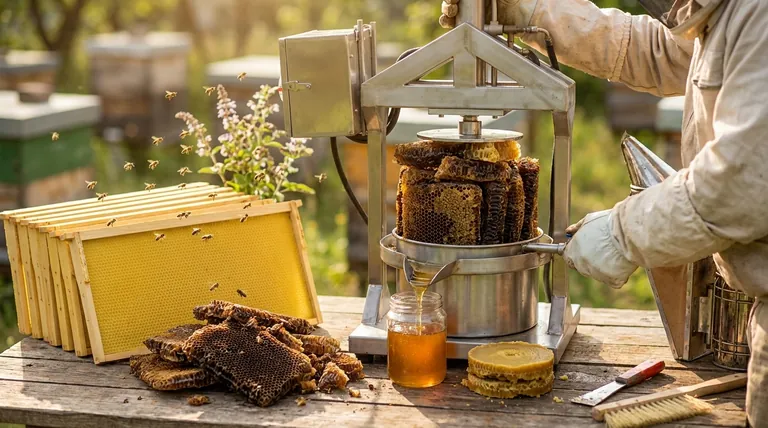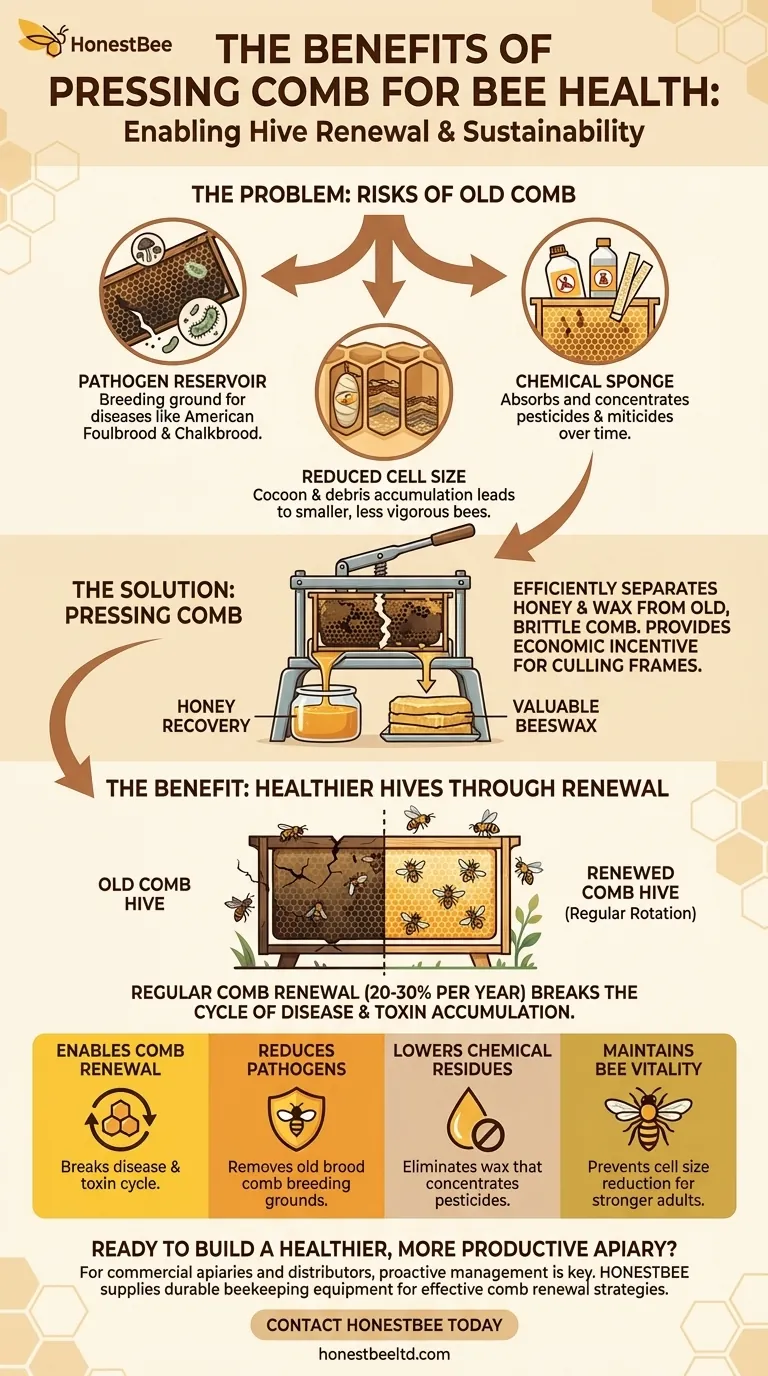While the act of pressing comb is a mechanical process for separating honey and wax, its primary benefit to bee health is indirect but significant: it incentivizes and simplifies the crucial practice of regular comb renewal. This renewal cycle reduces the long-term buildup of pathogens, chemical residues, and environmental toxins within the hive, creating a healthier nursery for the colony.
The true health benefit of pressing comb lies not in the press itself, but in how it turns old, potentially contaminated comb into a valuable resource (beeswax). This encourages beekeepers to regularly rotate out old frames, fundamentally breaking the cycle of disease and toxin accumulation in the hive.

Why Old Comb Poses a Health Risk
To understand the benefit of renewal, we must first recognize that honeycomb is more than just a storage container. It is the hive's nursery, its pantry, and its communication network all in one. Over time, it can become a source of chronic problems.
The Comb as a Pathogen Reservoir
Brood comb, where the queen lays her eggs and larvae are raised, is used repeatedly. With each generation, pupal cocoons, excrement, and other biological materials are left behind in the cells.
This accumulation creates a fertile breeding ground for a host of bee pathogens, including the hardy spores that cause American Foulbrood (AFB) and the fungi responsible for Chalkbrood.
A Sponge for Chemical Residues
Beeswax is lipophilic, meaning it naturally absorbs oils and fat-soluble compounds. This property makes it an effective "sponge" for pesticides, herbicides, and fungicides the bees inadvertently collect from the environment.
Crucially, it also absorbs the chemical miticides beekeepers use to control Varroa mites. Over several years, these residues can concentrate in the wax to levels that harm bee development and compromise the colony's immune system.
Reduced Cell Size and Bee Vitality
As cocoons and debris accumulate inside the brood cells over many cycles, their internal diameter slowly shrinks.
While the effect is minor with each generation, comb that is many years old can begin to produce slightly smaller, potentially less vigorous adult bees, impacting the overall strength of the colony's workforce.
How Pressing Comb Encourages Hive Renewal
The core challenge for a beekeeper is that old, dark brood comb is brittle and difficult to manage. A comb press elegantly solves this problem.
The Problem with Old, Brittle Comb
Standard centrifugal extractors are designed for new, pliable honey comb. They rely on spinning frames to force honey out of the cells. Using them on old, dark brood comb often results in the comb shattering, creating a mess and making wax recovery difficult.
Because bees expend enormous energy to draw out wax comb, beekeepers are often reluctant to simply destroy these old frames, leaving them in the hive far past their ideal lifespan.
Turning a Liability into a Resource
A comb press works through compression. It is specifically designed to take chunks of comb—regardless of age or condition—and squeeze them under high pressure.
This action efficiently separates the liquid honey from the solid wax. The honey can be recovered, and the wax is left in a compressed "puck" that is easy to collect and render into clean, usable blocks.
The Incentive for Good Husbandry
By making it simple to salvage both the remaining honey and the valuable wax from old frames, a press provides a clear economic incentive for the beekeeper.
The practice of culling old frames is no longer a "loss" of bee effort but a "harvest" of a secondary product. This directly encourages a proactive rotation schedule, which is the cornerstone of improved hive health.
Understanding the Trade-offs
A comb press is a powerful tool, but it is not a universal solution. It's essential to understand its place in a beekeeping operation.
Initial Investment and Labor
A comb press represents a financial investment compared to simpler methods like a basic solar wax melter. The process is also more labor-intensive than using a centrifugal extractor, often involving cutting comb out of frames and processing it in batches.
A Complementary Tool, Not a Replacement
For beekeepers focused solely on producing liquid honey from clean honey supers, a centrifugal extractor remains the most efficient tool. A press does not replace the extractor for this purpose.
Its true value is as a specialized tool for managing the brood chamber and processing comb that is unsuitable for extraction, thereby enabling the hive renewal cycle.
Making the Right Choice for Your Goal
Implementing a comb rotation strategy is one of the most effective long-term health management decisions a beekeeper can make. A press is a tool that makes this strategy practical.
- If your primary focus is maximizing hive health: Aim to replace 20-30% of your brood frames each year, ensuring no comb remains in the hive for more than 4-5 years. A press makes processing these old frames economically viable.
- If your primary focus is large-scale honey production: Continue using an extractor for clean honey supers, but integrate a press to manage old brood comb and cappings, improving long-term colony strength and productivity.
- If you are a new beekeeper with a limited budget: You can still practice comb renewal by manually cutting out and melting old comb. A press becomes a worthwhile investment as your operation grows and the volume of culled comb increases.
By viewing old comb not as waste but as a resource to be harvested, you fundamentally shift your management strategy toward proactive, preventative hive care.
Summary Table:
| Benefit of Pressing Comb | Key Impact on Bee Health |
|---|---|
| Enables Comb Renewal | Breaks the cycle of disease and toxin accumulation in the hive. |
| Reduces Pathogens | Removes old brood comb, a breeding ground for diseases like American Foulbrood. |
| Lowers Chemical Residues | Eliminates wax that absorbs and concentrates pesticides and miticides. |
| Maintains Bee Vitality | Prevents cell size reduction from old comb, supporting stronger adult bees. |
Ready to build a healthier, more productive apiary?
For commercial apiaries and distributors, proactive hive management is key to sustainability and profitability. HONESTBEE supplies the durable, wholesale-focused beekeeping equipment you need to implement effective comb renewal strategies.
Contact HONESTBEE today to discuss how our comb presses and other supplies can protect your investment and strengthen your colonies.
Visual Guide

Related Products
- Electric Honey Press Machine for Squeezing Honey Comb Press Equipment
- Easy Use Manual Stainless Steel Honey Press for Honey Comb
- Notebook Style Beeswax Foundation Mould Wax Foundation Mold
- Stainless Steel Honey Press Wax Press with Tank
- 10L Stainless Steel Electric Honey Press Machine
People Also Ask
- How does using a honey press affect honeycomb reuse? It Destroys Comb but Captures Unique Honey & Wax
- How does a honey press work? A Guide to Simple, High-Yield Honey Extraction
- How should a honey press be cleaned? A Step-by-Step Guide for Beekeepers
- What are the reasons for choosing a honey press over a dedicated honey extractor? Maximize Disease Control and Natural Beekeeping
- How was the honey press cleaned after use? Quick vs. Deep Cleaning Methods Explained



















